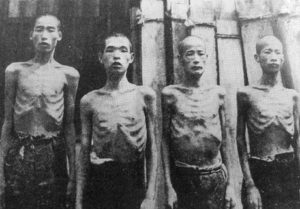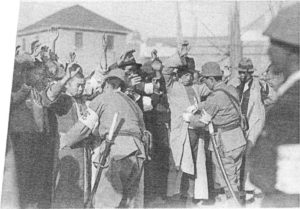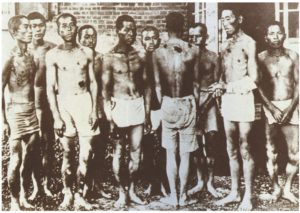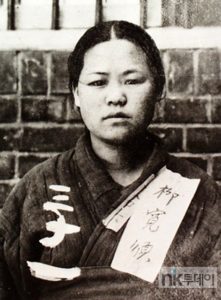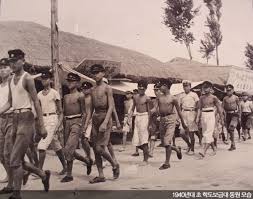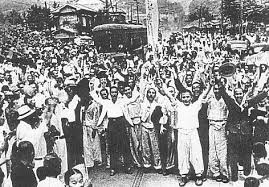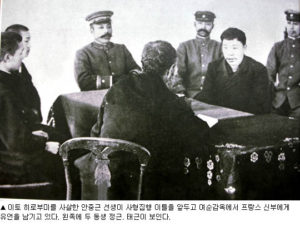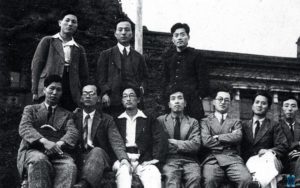How Japan Took Control of Korea
Between 1910 and 1945, Japan worked
to wipe out Korean culture, language and history.
BY ERIN BLAKEMORE
Japanese troops occupying Korea
in the early 1900s.
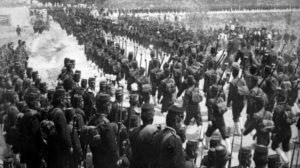
(Credit: Art Media/Print Collector/Getty Images)
During the 2018 Olympic Winter Games,
outraged South Koreans demanded
an apology from NBC after
a commentator asserted that
Korea’s transformation into
a global powerhouse was
due to the “cultural, technological
and economic example” of Japan.
For many South Koreans,
analyst Joshua Cooper Ramo’s
statement reopened old wounds—
ones carved by a generation of
occupation of the country by Japan.
Any reasonable person familiar with
the history of Japanese imperialism,
and the atrocities it committed
before and during WWII, would find
such a statement deeply hurtful
and outrageous,” read the apology petition
signed by tens of thousands of
South Koreans.
In 1910, Korea was annexed
by the Empire of Japan after years of war,
intimidation and political machinations;
the country would be considered
a part of Japan until 1945.
In order to establish control over
its new protectorate, the Empire of Japan
waged an all-out war on Korean culture.
Schools and universities
forbade speaking Korean
and emphasized manual labor
and loyalty to the Emperor.
Public places adopted Japanese, too,
and an edict to make films in Japanese
soon followed. It also became a crime
to teach history from non-approved texts
and authorities burned over 200,000
Korean historical documents,
essentially wiping out
the historical memory of Korea.

Japanese officers in Korea.
(Credit: Topical Press Agency/Getty Images)
During the occupation,
Japan took over Korea’s laborand land.
Nearly 100,000 Japanese families
settled in Korea with land
they had been given; they chopped down trees
by the millions and planted non-native species,
transforming a familiar landscape into
something many Koreans didn’t recognize.
Nearly 725,000 Korean workers were
made to work in Japan and its other colonies,
and as World War II loomed, Japan forced
hundreds of thousands of Korean women
into life as“comfort women”—sexual slaves
who served in military brothels.
Korea’s people weren’t the only thing
that were plundered during Japan’s colonization—
its cultural symbols were considered fair game, too.
One of the most powerful symbols of
Korean sovereignty and independence was
its royal palace, Gyeongbokgung,
which was built in Seoul in 1395
by the mighty Joseon dynasty.
Soon after assuming power,
the Japanese colonial government
tore down over a third of
the complex’s historic buildings,
and the remaining structures were
turned intotourist attractions
for Japanese visitors.
As historian Heejung Kangnotes,
the imperial government also attempted to
preserve treasures of Korean art history
and culture—but then used them to uphold
imperial Japan’s image of itself as a civilizing
and modern force. This view of Korea as backwards
and primitive compared to Japan made it
into textbooks, museums and even
Koreans’ own perceptions
of themselves.
The Shrine of One Thousand Steps,
the Shinto shrine which was built in 1925
from forced Korean donations,
still remains but is used as a city park.
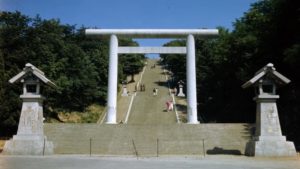
(Credit: Bettmann Archive/Getty Images)
The occupation government
also worked to assimilate Koreans
with the help of language, religion
and education. Shinto shrines originally
intended for Japanese families became
places offorced worship.
The colonial government made Koreans
“worship the gods of imperial Japan,
including dead emperors and
the spirits of war heroes
who had helped them
conquer Korea earlier
in the century,” explains
historian Donald N. Clark.
This forced worship was
viewed as an act of cultural genocide
by many Koreans, but for the colonists,
it was seen as evidence that Koreans
and Japanese were a single, unified people.
Though some families got around
the Shinto edict by simply visiting
the shrines and not praying there,
others grudgingly adopted
the new religious practices
out of fear.
By the end of its occupation of Korea,
Japan had even waged war on
people’s family names. At first,
the colonial government made it illegal
for people to adopt Japanese-style names,
ostensibly to prevent confusion in
family registries. But in 1939,
the government made changing names
an official policy. Under the law,
Korean families were “graciously allowed”
to choose Japanese surnames.
At least84 percent of all Koreans took
on the names, since people who lacked
Japanese names were not recognized
by the colonial bureaucracy and were
shut out of everything from mail delivery
to ration cards. “The whole point was
for the government to be able to say that
the people had changed their names
‘voluntarily’,”writes historian Hildi Kang.
Though Japan occupied Korea
for an entire generation,
the Korean people didn’t submit passively
to Japanese rule. Throughout the occupation,
protest movements pushed for
Korean independence. In 1919,
the March First Movement proclaimed
Korean independence and more than 1,500
demonstrations broke out. The protests were
brutally suppressed by the Japanese,
but not before the desire for independence
swept through Korea.
1st March 1948: Some of the 80,000 Koreans
gathering in 1948 to commemorate
Korea’s Declaration of Independence
from Japan on March 1, 1919. (Credit: Paul
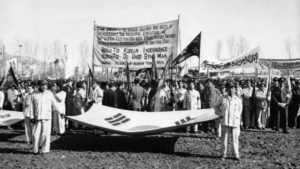
Popper/Popperfoto/Getty Images)
Later, underground groupslike
the Party of Three Thousand,
a group of students that tried to undermine
the Japanese military after being conscripted
to fight in World War II, were formed.
Koreans also protested in their own
quiet ways. Some refused to speak Japanese
or change their names; others came up with
names that reflected their family history
or contained subtle resistance to the policy.
World War II devastated not just Japan,
but the Korean Peninsula, and in 1945,
the United States and the USSR captured
the peninsula and ended Japanese rule there.
Korea was divided into two occupation zones
that were intended to be temporary.
However, a unified state was never given back
to the newly independent Korean people.
Instead, the Korean War broke out
between the Soviet and Chinese-backed
northern half of Korea
and the United States and
United Nations-backed south.
After the Korean War,
South Korea transformed into
a liberal democracy and tried to purge itself
of the remnants of Japanese rule.
The country prosecuted a small number
of colonial collaborators immediately
after World War II, and some of their land was
confiscated. Today, disputes continue about
how and whether to prosecute those who
worked with the Japanese government
during the occupation.
While South Korea still grapples
with the fallout of Japan’s brutal occupation,
it hasn’t forgotten its resistance.
Today, March 1—the day of the independence
protest in 1919—is a national holiday
in South Korea, a reminder not just of
the resilience of the Korean people,
but of the years of occupation
they withstood.
Citation Information
Article Title
How Japan Took Control of Korea
Author
Erin Blakemore
Website Name
HISTORY
URL
https://www.history.com/news/japan-colonization-korea
Access Date
July 30, 2019
Publisher
A&E Television Networks
Last Updated
August 29, 2018
Original Published Date
February 28, 2018
From: History
*영국이나 미국의 명문대학에서
영문학 박사학위나 역사학 박사학위를
이수하신 분들이 훌륭한 영어로
우리역사를 쓰는 모범된 사례가
많아 지기를 소망합니다.
좋은글 감사합니다
http://www.loaloachristiannetwork.com/
<Photo from app>
